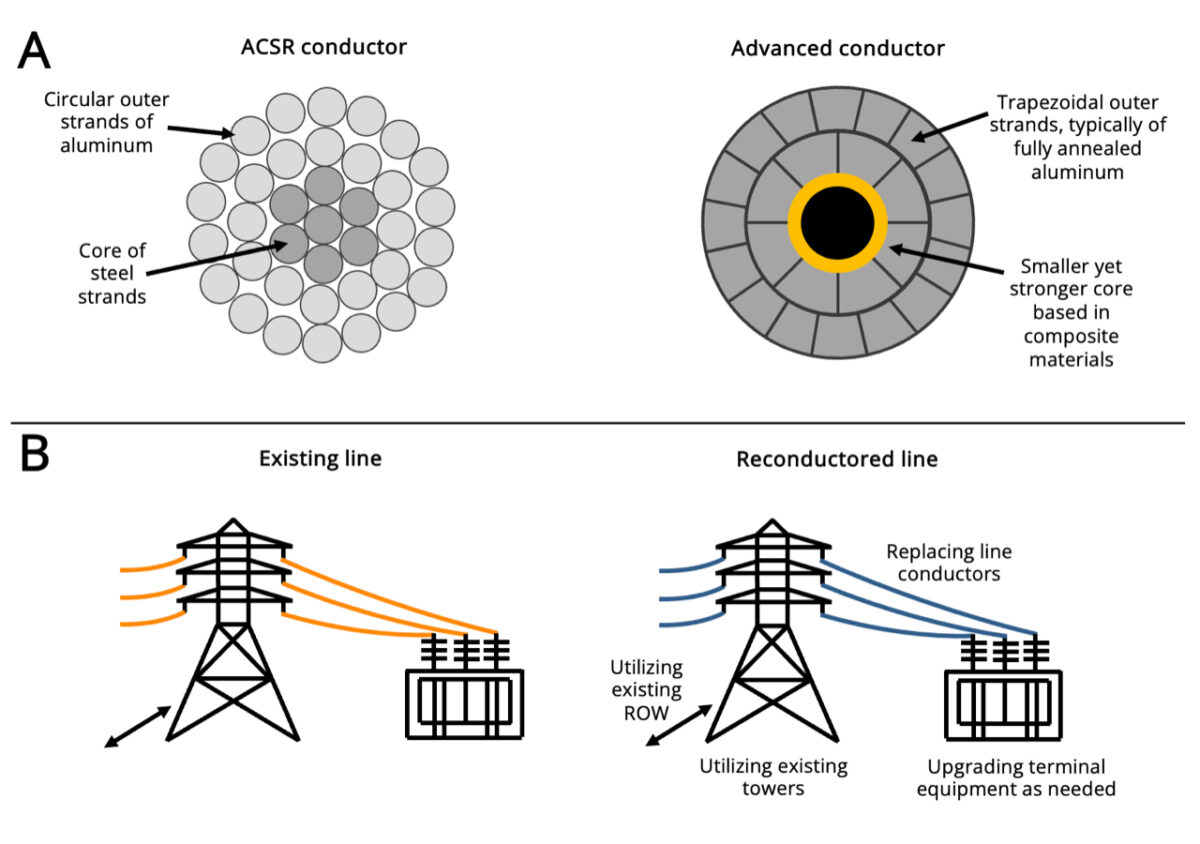From pv magazine USA
Replacing the conductors on existing transmission lines can rapidly increase transmission capacity and “unlock” renewable energy at lower cost than building transmission in new rights-of-way, found a study from the Energy Institute at the UC Berkeley Haas School of Business.
Advanced conductors can carry twice as much power as conventional conductors, the study says. With reconductoring, existing transmission lines are replaced with reconductored lines that are strung along existing transmission towers in existing rights of way, with upgraded terminal equipment as needed, as shown in the bottom portion of the image.
By avoiding the need for new rights-of-way, reconductoring avoids time-consuming and costly processes for land acquisition and permitting. Reconductoring can meet over 80% of the transmission needed to reach 90% clean power by 2035, the authors found.
With reconductoring at scale, solar, wind and storage projects near the existing transmission network could be interconnected more easily. The study includes several maps of specific sites with “cost-effective, high-quality” renewable resources located near the existing transmission network, obtained from the Regional Energy Deployment System (ReEDs) model.
Researchers from UC Berkeley and the consultancy GridLab used the ReEDS model to conduct the study. Under their base case with high electrification and allowing reconductoring, co-optimizing generation and transmission expansion would lower wholesale electricity costs by 3-4%, compared to not allowing reconductoring. By 2050, system cost savings from large-scale reconductoring would total $180 billion.
Popular content
In both of the two scenarios modeled, which considered restricted or unrestricted transmission buildout, reconductored capacity accounted for the majority of capacity installed before 2030. The authors say reconductoring presents an opportunity for expanding transmission capacity in the next few years while new transmission lines are planned and permitted.
The study projected that the optimal added transmission capacity by 2050, allowing for reconductoring, would be about 90,000 GW-miles with restricted buildout or about 190,000 GW-miles with unrestricted buildout. The U.S. Department of Energy has estimated that 54,500 GW-miles of additional within-region transmission capacity are needed for a clean grid.
The study says that previous work “has established that it is cost-effective and time-efficient” to expand transmission capacity by reconductoring existing lines, and there is “robust global deployment” of advanced conductors, yet the technology has seen “only limited uptake” in the US. A study appendix describes reconductoring deployments in five countries and in Texas.
To “spur uptake” of reconductoring, the authors proposed policy measures that could be undertaken by:
- Either the U.S. Department of Energy (DOE) or IEEE, the global society of engineers
- The Federal Energy Regulatory Commission
- DOE’s Grid Deployment Office
- DOE’s Loan Programs Office
- Utilities
- Transmission owners, and grid operators known as ISOs and RTOs.
The study is titled “Accelerating transmission expansion by using advanced conductors in existing right-of-way.” The authors say they plan to investigate the potential for large-scale reconductoring in other global regions.
This content is protected by copyright and may not be reused. If you want to cooperate with us and would like to reuse some of our content, please contact: editors@pv-magazine.com.


This is akin to fixing up a beat-up old house just enough to be sold, to be torn down by the new owner to build his new home .. The future is for each place to be powered by their own local renewable resources, not requiring transmission lines from far away centralized power plants. Present investments should prioritize building up new renewable sources in each local environment and strengthen their grid forming capabilities .. as the future will be millions of locally connected mini-smartgrids ..